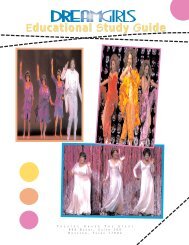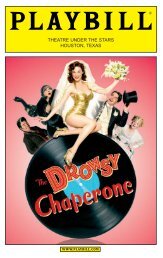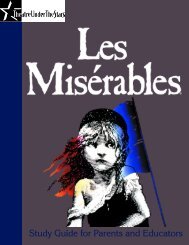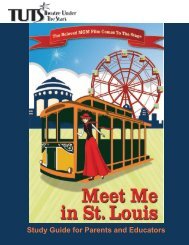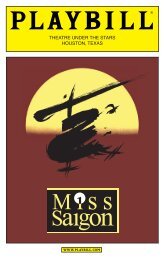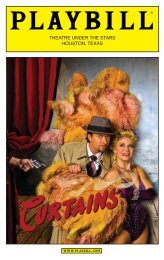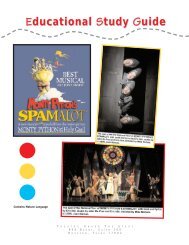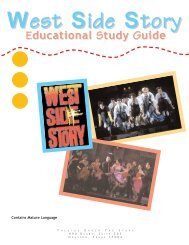The Drowsy Chaperone Study Guide - Theatre Under The Stars
The Drowsy Chaperone Study Guide - Theatre Under The Stars
The Drowsy Chaperone Study Guide - Theatre Under The Stars
You also want an ePaper? Increase the reach of your titles
YUMPU automatically turns print PDFs into web optimized ePapers that Google loves.
Music & Lyrics by Lisa Lambert and Greg Morrison<br />
Book by Bob Martin and Don McKellar<br />
S T U D Y G U I D E<br />
By<br />
Peter Royston<br />
Bob Martin as “Man in Chair”
<strong>The</strong> <strong>Drowsy</strong> <strong>Chaperone</strong> is a unique combination of the past and the<br />
present: a brand new Broadway musical that celebrates musical<br />
theatre!<br />
<strong>The</strong> <strong>Drowsy</strong> <strong>Chaperone</strong> begins when a die-hard musical-theatre fan<br />
plays his favorite cast album, and the musical magically bursts to life!<br />
We are instantly immersed in the hilarious tale of a glamorous bride<br />
and her uproarious wedding day, complete with thrills and surprises<br />
that take both the cast (literally) and the audience (metaphorically)<br />
soaring into the heavens.<br />
Students will love <strong>The</strong> <strong>Drowsy</strong> <strong>Chaperone</strong>’s cutting sense of humor<br />
and its headlong theatrical momentum; educators will appreciate<br />
the opportunity to use the show as a launch point for discussions and<br />
activities based on the use of comedy in literature and theatre, the<br />
history of the 1920s and the influence of the American Musical.<br />
This study guide for <strong>The</strong> <strong>Drowsy</strong> <strong>Chaperone</strong> explores this hilarious show<br />
in an interdisciplinary curriculum that takes in English/Language Arts,<br />
History/Social Studies, Music and <strong>The</strong>atre. And of course, mirroring<br />
the show’s madcap sense of humor, expect some puzzles and games,<br />
too!<br />
Completely original material is such a rarity on Broadway nowadays.<br />
Students, especially those who have never been to the theatre before,<br />
will come away from <strong>The</strong> <strong>Drowsy</strong> <strong>Chaperone</strong> with a tremendous<br />
sense of possibility: the potential of what theatre, or any art form, can<br />
achieve.<br />
2<br />
Bob Martin as “Man in Chair”
Man in Chair: Our narrator, he describes the action and<br />
music of <strong>The</strong> <strong>Drowsy</strong> <strong>Chaperone</strong><br />
Mrs. Tottendale: <strong>The</strong> wealthy widow at whose estate the<br />
wedding is to take place<br />
<strong>Under</strong>ling: Mrs. Tottendale’s butler<br />
Janet Van De Graaff: A former showgirl, she’s ready to give up<br />
show-business to get married<br />
<strong>The</strong> <strong>Drowsy</strong> <strong>Chaperone</strong>: Janet’s companion, weary of the world<br />
Robert Martin: <strong>The</strong> Groom<br />
George: Robert’s Best Man<br />
Feldzieg: Janet’s producer, who hopes the wedding<br />
will fall apart<br />
Kitty: A chorus girl<br />
Aldolpho: A womanizing cad<br />
Pastry Chefs: Two gangsters disguised as pastry chefs<br />
who are demanding money from Feldzieg<br />
Trix: An aviatrix, or a female airplane pilot<br />
Welcome to the study guide,<br />
there’s so much more inside!<br />
3
Let’s have a treat!<br />
In his book, Facets of Comedy (Grosset & Dunlap, 1972), Walter<br />
Sorrell writes, “Laughter is a psychological and physiological<br />
phenomenon, comedy the act of man’s humorous capacity.”<br />
Whew! Large words just for making people laugh. But comedy can<br />
be serious business. As the English actor Donald Wolfit once said,<br />
“Dying is easy; comedy is hard.”<br />
Although full of joyous fun, <strong>The</strong> <strong>Drowsy</strong> <strong>Chaperone</strong> can teach an<br />
important lesson. <strong>The</strong> ability to not take things seriously, to look at<br />
life and art with a humorist’s eye, is an important one to nurture in<br />
young people, especially in these increasingly serious times. Comedy<br />
can be a carefree interruption to life’s troubles, a solace to grief,<br />
or even a weapon against authority.<br />
Libarry of Congress<br />
Mark Twain gave his readers plenty<br />
to laugh about with novels like<br />
Huckleberry Finn and <strong>The</strong> Prince<br />
and the Pauper!<br />
4<br />
Man in Chair, from <strong>The</strong> <strong>Drowsy</strong> <strong>Chaperone</strong><br />
What makes us laugh can often be a reflection of our culture<br />
and the times in which we live. <strong>The</strong> <strong>Drowsy</strong> <strong>Chaperone</strong> is a<br />
celebration of the musicals of the 1920s, and it faithfully<br />
captures the spirit of that wild, carefree age. Throughout<br />
history, comic writers like Aristophanes, Jonathan Swift, Mark<br />
Twain, James Thurber, P.D. Wodehouse, Dorothy Parker,<br />
and more modern wits like Lenny Bruce, Woody Allen,<br />
Richard Pryor and Al Franken have played a vital role in the<br />
life of society. Especially today, young people need to look<br />
at sacred cows with an analytical, comedian’s gaze.<br />
Looking at life’s funny side is an important skill to develop.<br />
<strong>The</strong> <strong>Drowsy</strong> <strong>Chaperone</strong> will be a perfect launching point<br />
for discussions about the history and importance of comedy.<br />
By connecting <strong>The</strong> <strong>Drowsy</strong> <strong>Chaperone</strong> to other forms of<br />
humor they experience every day, and creating their own<br />
comic writing, students will see themselves as part of a long,<br />
and important, lineage: those who have made us laugh,<br />
and made us think, through comedy.
Man in Chair:<br />
When you see <strong>The</strong> <strong>Drowsy</strong> <strong>Chaperone</strong>, you’ll meet many fun and<br />
interesting characters. How would you describe them to someone who<br />
hasn’t seen the show? After seeing <strong>The</strong> <strong>Drowsy</strong> <strong>Chaperone</strong>, write down<br />
three describing words for each of the characters in the show. Do any<br />
characters share words?<br />
5<br />
Robert Martin:<br />
Mrs. Tottendale: George:<br />
<strong>Under</strong>ling: Feldzieg:<br />
Janet Van De Graaff: Kitty:<br />
<strong>The</strong> <strong>Drowsy</strong> <strong>Chaperone</strong>: Aldolpho:
Create a scrapbook based on the characters in <strong>The</strong><br />
<strong>Drowsy</strong> <strong>Chaperone</strong>. Break your class or group up into<br />
smaller groups, enough so that each group is assigned<br />
one character from the musical. Each group will<br />
choose or be assigned one of the characters from<br />
<strong>The</strong> <strong>Drowsy</strong> <strong>Chaperone</strong>.<br />
Using the describing words you wrote down on page<br />
5 as a foundation, create a one-page collage based<br />
on your character.<br />
First, cut out the photo of your character from the<br />
gallery on page 5, and attach it to a piece of paper<br />
with the adhesive of your choice. <strong>The</strong>n add the rest<br />
of your collage.<br />
Possible items for your collage:<br />
· Photos from magazines or the Internet that remind you of your<br />
character.<br />
· Photos from magazines or the Internet of props similar to those<br />
used by your character in the show.<br />
· Write down, in long hand or on a computer, a favorite line said<br />
or sung by your character in the show (don’t worry if you don’t<br />
get it exactly right!)<br />
· Your own drawing of your character.<br />
· Your own drawing of a scene from the show featuring your<br />
character.<br />
6
Comedy has been a popular art form for thousands of<br />
years. Audiences and readers love to laugh; they love<br />
to be taken to a carefree place by artists and forget<br />
their troubles for a while. How have writers and artists<br />
made us laugh over the centuries? Read one comic<br />
novel or play. Here are some suggestions:<br />
Aristophanes <strong>The</strong> Birds<br />
William Shakespeare As You Like It, A Midsummer Night’s Dream, Much Ado About Nothing<br />
Ben Jonson <strong>The</strong> Alchemist<br />
Moliere <strong>The</strong> Miser, <strong>The</strong> Misanthrope<br />
Woody Allen <strong>The</strong> Complete Prose of Woody Allen<br />
P.G. Wodehouse Very Good, Jeeves!<br />
James Thurber Writings and Drawings<br />
Sandra Cisneros Carmelo<br />
Eric Hodgins Mr. Blandings Builds His Dream House<br />
Aaron Mcgrunder Birth of a Nation: A Comic Novel<br />
Jon Stewart <strong>The</strong> Daily Show with Jon Stewart Presents America (<strong>The</strong> Book): A Citizen's<br />
<strong>Guide</strong> to Democracy Inaction<br />
Doug Adams <strong>The</strong> Hitchhiker’s <strong>Guide</strong> to the Galaxy<br />
Mark Twain Puddinhead Wilson<br />
Neil Gaiman Good Omens<br />
Charles Dickens <strong>The</strong> Pickwick Papers<br />
Why was the novel or play you chose funny? Write down three elements<br />
that made it funny for you:<br />
1.<br />
2.<br />
3.<br />
Write down any comic elements your novel or play shared with <strong>The</strong> <strong>Drowsy</strong> <strong>Chaperone</strong>:<br />
Libarry of Congress<br />
Shakespeare Dickens<br />
7<br />
Libarry of Congress
1.<br />
2.<br />
3.<br />
4.<br />
5.<br />
DID YOU KNOW?<br />
What makes a wedding so funny? <strong>The</strong> <strong>Drowsy</strong> <strong>Chaperone</strong> shares one<br />
element with many famous comedies, such as William Shakespeare’s<br />
A Midsummer Night’s Dream or As You Like It: they end with a wedding.<br />
What is it about a wedding that makes it the perfect ending to a<br />
comedy?<br />
Imagine that you’ve met someone from Mars, who doesn’t know<br />
about our strange wedding rituals here on Earth. Write 5 sentences<br />
describing a wedding.<br />
*<br />
Just as in the musical, the real-life story of <strong>The</strong> <strong>Drowsy</strong> <strong>Chaperone</strong>’s<br />
creation is full of love and marriage!<br />
Man in Chair is played by Bob Martin, who co-wrote the musical<br />
as a wedding gift for his real-life wife, Janet Van De Graaff<br />
(complete with their names as the fictional bride and groom!).<br />
Visit www.drowsychaperone.com/features.php# to<br />
see one of <strong>The</strong> <strong>Drowsy</strong> <strong>Chaperone</strong>’s producers marry<br />
his fiancée on stage after the show.<br />
Compare your list with others in your class or group. Choose<br />
one aspect – how could it be retold in a funny way?<br />
8
Monday<br />
Tuesday<br />
Wednesday<br />
Thursday<br />
Friday<br />
Saturday<br />
Sunday<br />
What makes you laugh? Create a comedy journal. Over a one week<br />
period, write down the funny things you see and experience, both in<br />
popular culture and in your own life. Make a list of the TV shows you<br />
may have watched, movies you may have seen, comic strips or books<br />
you may have read or Internet sites you may have clicked on. For the<br />
same day, write down any funny things that may have happened to<br />
you, your family or friends.<br />
POPULAR CULTURE REAL LIFE<br />
*<br />
Choose one item from popular culture, and one item<br />
from real life. What about them was so funny? Explain<br />
in a short paragraph. Compare with others in your class<br />
or group. Is there a consensus about what is funny<br />
today? Are there any elements in what you found funny<br />
over the week that were shared with <strong>The</strong> <strong>Drowsy</strong><br />
<strong>Chaperone</strong>?<br />
9
1.<br />
2.<br />
3.<br />
4.<br />
5.<br />
1.<br />
2.<br />
3.<br />
Can you find comedy in a stressful situation? How about in school?<br />
Often the best comedy blossoms from the most awkward or difficult<br />
situations.<br />
Create your own comic story about school<br />
life. First, brainstorm five school events that<br />
might prove to be difficult or stressful (i.e.<br />
taking a test):<br />
Now, focus on one of your choices above.<br />
Brainstorm ideas on how the situation you’ve<br />
chosen might be seen in a comic way. Write<br />
three ways the situation you’ve chosen might<br />
develop in a humorous fashion (to an<br />
audience or a reader, if not to the people<br />
involved!):<br />
10<br />
NAME:<br />
DESCRIPTION:<br />
NAME:<br />
DESCRIPTION:<br />
NAME:<br />
DESCRIPTION:<br />
Who are the characters in the situation you’re<br />
developing? Below, write their names and a<br />
one sentence description of each character.<br />
If these are based on real-life people, change<br />
their names:<br />
Where does your comic situation take place?<br />
Including as much detail as possible, write a<br />
brief description of the setting of your comic<br />
situation:<br />
Using your ideas (and a separate piece of<br />
paper), write a short comic story about<br />
school life.
Here are some terms you will hear in <strong>The</strong> <strong>Drowsy</strong> <strong>Chaperone</strong>.<br />
Can you pick the right definition?<br />
CHAPERONE:<br />
1. a person, usually a married or older woman, who, for propriety,<br />
accompanies a young unmarried woman in public<br />
2. a German pastry, made with raisins and sherry<br />
3. a lone sheep left in the field after sundown<br />
ROLLICKING:<br />
1. a stinging sensation of the tongue<br />
2. carefree and joyous<br />
3. desperate and callous<br />
OVERTURE:<br />
1. being overly old; mature<br />
2. an orchestral composition forming the prelude or introduction to<br />
an opera, oratorio, or musical<br />
3. to do to excess; overindulge<br />
AVIATRIX:<br />
1. a woman who is a pilot; aviator<br />
2. apt or tending to deceive<br />
3. readily obtainable<br />
DEBONAIR:<br />
1. a first public appearance on a stage<br />
2. the act of throwing someone named “Deborah” up high<br />
3. courteous, gracious, and having a sophisticated charm<br />
NUPTIALS:<br />
1. food supplies; provisions<br />
2. of or pertaining to marriage or the marriage ceremony<br />
3. of or pertaining to seeing or sight<br />
JITTERS:<br />
1. to be nervous or uneasy<br />
2. a strenuously acrobatic dance consisting of a few standardized steps<br />
augmented by twirls, splits, somersaults, etc.<br />
3. a tasty, salty snack<br />
ENCORE:<br />
1. the central part of a fleshy fruit<br />
2. a sculptured representation of a young woman, esp. one produced prior<br />
to the 5th century b.c.<br />
3. a demand, as by applause, for a repetition of a song, act, or performance<br />
SCOUNDREL:<br />
1. a rounded rod, usually of wood, tapering toward each end, used in handspinning<br />
2. an unprincipled, dishonorable person<br />
3. one of the carts used during the French Revolution to convey victims to the<br />
guillotine.<br />
DROWSY:<br />
1. sleepy, sluggish<br />
2. nearly drowning<br />
3. unable to stop speaking<br />
11
“Imagine, if you will, it’s November, 1928.<br />
You’ve just arrived at the doors of the<br />
Morosco <strong>The</strong>atre in New York. It doesn’t<br />
exist anymore, it was torn down in 1982,<br />
and replaced with an enormous hotel. It’s<br />
awful. Unforgivable. Anyway, it’s very cold<br />
and a heavy grey sleet is falling from the<br />
sky but you don’t care because you’re going<br />
to see a Broadway show! Listen!”<br />
12<br />
Man in Chair, from <strong>The</strong> <strong>Drowsy</strong> <strong>Chaperone</strong><br />
Sometimes after a great shock or sorrow,<br />
you just want to have a party. That’s what<br />
the 1920s were: one long, fabulous, roaring<br />
party of a decade after years of horror<br />
and war. World War I had brought the<br />
world so much death; tens of thousands of young men had been<br />
lost. <strong>The</strong> old ways of behaving, the old moralities, seemed oldfashioned.<br />
People had had enough of reality – they wanted<br />
spectacle and romance, fun and frivolity. Solemnity and seriousness<br />
were out – fun and spectacle were in. <strong>The</strong> American people<br />
wanted a new way of looking at the world, a new perspective.<br />
And they got it, in their music, their clothes, their architecture, and<br />
especially in their theatre.<br />
Jazz was the soundtrack of this wild new era, and musical theatre<br />
artists did not hesitate to use this uniquely American sound in their<br />
shows. If America broke its political ties with Europe in 1776, it finally<br />
broke away theatrically during the 20s. During the 19th century,<br />
the European operetta had been the model for American theatre,<br />
but, like all of American culture, something new was needed. As<br />
Prince Dorough says in Popular-Music Culture in America, “<strong>The</strong><br />
1920s musicals ...avoided the sentimentality and slightly aristocratic<br />
tone that came from Viennese operetta. American musical<br />
comedies were brassy and brash, lively and spicy, colloquial and<br />
earthy. <strong>The</strong>y employed more of the elements of dance and music<br />
that were identifiably American, and they accurately reflected<br />
the optimism and hedonism, the frenetic energy, and the<br />
abandoned, carefree attitudes of the postwar-boom era.” This is<br />
the joyous passion that <strong>The</strong> <strong>Drowsy</strong> <strong>Chaperone</strong> celebrates.
1900-1910<br />
1911-1920<br />
1921-1930<br />
1931-1940<br />
In his 1877 essay, “An Essay on Comedy,” George Meredith writes,<br />
“comedy teaches the world to understand what ails it.” How has comedy<br />
changed over the years? Create a comic timeline of the 20th century.<br />
Break your class or group up into ten smaller groups; every group will<br />
be assigned one of the decades of the 20th century. Using at least three<br />
Internet or Library resources, research the comedy of that decade.<br />
Using the timeline below, write the titles and authors of three novels,<br />
plays, comic poems, movies, television shows or web sites that were<br />
created during your decade.<br />
1941-1950<br />
<strong>The</strong> <strong>Drowsy</strong> <strong>Chaperone</strong> - Original Broadway cast<br />
(Pictured) <strong>The</strong> Company of <strong>The</strong> <strong>Drowsy</strong> <strong>Chaperone</strong><br />
Joan Marcus, 2006<br />
1951-1960<br />
1961-1970<br />
13<br />
1971-1980<br />
1981-1990<br />
1991-2000
Use the space below to brainstorm on the following discussion points:<br />
Discuss the important historical events of the decade you have<br />
chosen. Write a one-paragraph reflection on this idea: “Comedy is<br />
influenced by the times in which it is created.”<br />
Focus your discussions on the 1920s. How did the musicals of the<br />
1920s reflect the times in which they were created? Consider that<br />
Bob Martin, one of the creators of <strong>The</strong> <strong>Drowsy</strong> <strong>Chaperone</strong> passionately<br />
believes in the healing power of musical theatre, saying, “<strong>The</strong>re’s<br />
something very healing about being transported by a romantic fantasy.”<br />
How can escapism help us to heal? How was the 1920s musical, with its<br />
defiant sense of humor, a direct answer to the horrors of World War I?<br />
How did musicals change after the Stock Market Crash of 1929?<br />
Go back to your Comedy Journal (page 9). Compare some of your<br />
comic findings from your week-long research with some of the comic<br />
art forms you researched for your part of the timeline. How does the<br />
comedy you watch reflect the times in which you live today?<br />
14
“It does what a musical is supposed to<br />
do: it takes you to another world. And<br />
it gives you a little tune to carry in<br />
your head, you know? A little something<br />
to take you away from the dreary<br />
horrors of the real world. A little<br />
something for when you’re feeling blue.<br />
You know?”<br />
15<br />
Man in Chair, from <strong>The</strong> <strong>Drowsy</strong> <strong>Chaperone</strong><br />
<strong>The</strong> <strong>Drowsy</strong> <strong>Chaperone</strong> is a celebration of the healing powers of theatre.<br />
As we’ve seen, after World War I, the world was tired of the “dreary horrors<br />
of the real world.” <strong>The</strong> musical theatre of the 1920s was an answer to that<br />
weariness. Audiences did not come to the theatre for realism, they came<br />
to be transported; they came for spectacle, for fascinating characters,<br />
clever lyrics and melodies you would always remember. <strong>The</strong>y came for a<br />
happy ending. In real life and in his stage persona as Man in Chair, Bob<br />
Martin longs for the days when musicals had the funny, absurd and joyous<br />
atmosphere that <strong>The</strong> <strong>Drowsy</strong> <strong>Chaperone</strong> matches so perfectly.<br />
What about you? How do you feel about musical theatre? Is <strong>The</strong> <strong>Drowsy</strong><br />
<strong>Chaperone</strong> the first musical you’ve ever seen? Can theatre heal and restore<br />
today, as it did in the 1920s?
Gestures:<br />
Body Language:<br />
Body Movements:<br />
Facial Expressions:<br />
During the 1920s, musical theatre thrived, but another form of art was<br />
blossoming that would soon overtake theatre’s popularity. <strong>The</strong> first movies<br />
were created in the late 19th century. <strong>The</strong> first films were silent films, and<br />
many of them were comedies.<br />
Silent film comedians like Charlie Chaplin, Buster Keaton, Harold Lloyd and<br />
Jean Harlow (many of whom started in live theatre) held the attention of<br />
their audiences and generated laughs using only gestures, body language<br />
and movements and facial expressions. A whole world was created without<br />
any sound.<br />
Watch a silent film comedy (see Resource section for some suggestions).<br />
As you watch the film, use the chart below to write down gestures, body<br />
language and movements and facial expressions that the actors use to<br />
create humor and tell the story.<br />
16<br />
Charlie Chaplin<br />
Think about it: <strong>The</strong><br />
<strong>Drowsy</strong> <strong>Chaperone</strong> is<br />
supposed to have taken<br />
place in 1928. Why is that<br />
year significant in the<br />
history of theatre and<br />
the movies?<br />
Libarry of Congress
Gestures:<br />
Body Language:<br />
Body Movements:<br />
Facial Expressions:<br />
How do the actors in <strong>The</strong> <strong>Drowsy</strong> <strong>Chaperone</strong> use the “vocabulary”<br />
of silent films? When you see <strong>The</strong> <strong>Drowsy</strong> <strong>Chaperone</strong>, watch for<br />
gestures, body language, facial expressions used to create humor<br />
without words or music. How are they similar to what you saw in<br />
silent movies? How are they different?<br />
17
Here’s a fun and enlightening theatre game that was used during the<br />
rehearsals of <strong>The</strong> <strong>Drowsy</strong> <strong>Chaperone</strong>!<br />
Interviews are a part of life. You get interviewed for a job or when you’re<br />
applying for a school. Actors and politicians are interviewed on television,<br />
the Internet and newspapers. Performers are often interviewed as part of<br />
the audition process.<br />
Now’s your chance to interview the different characters from <strong>The</strong> <strong>Drowsy</strong><br />
<strong>Chaperone</strong>! After seeing the show, have each member of your class or<br />
group choose one of the characters from the show from the list on page<br />
3. One at a time, each member of your class or group will sit in the “hot<br />
seat” in front of everyone else. Once in that seat, you are no longer yourself,<br />
you are the character from the show you have chosen! Class or group<br />
members will ask the character questions, and the person in the “hot seat”<br />
must fully answer in the personality and voice of the character. Remember,<br />
no one word answers: you must explain WHY!<br />
Possible questions:<br />
Favorites: what’s your favorite color? Movie? Musical? Time of<br />
Day? Food? Drink?<br />
What do you think about Musical <strong>The</strong>atre?<br />
What are your hobbies?<br />
What are your weaknesses? What are your strengths?<br />
What are you goals in life?<br />
Do you like to take risks?<br />
Do you work well under pressure?<br />
What can you do that the other characters cannot?<br />
18
“STILL WE BUMBLE OUR WAY<br />
THROUGH LIFE’S CRAZY LABYRINTH<br />
BARELY KNOWING LEFT FROM RIGHT<br />
OR RIGHT FROM WRONG<br />
AND THE BEST THAT WE CAN DO<br />
IS HOPE A BLUEBIRD<br />
WILL SING HIS SONG<br />
AS WE STUMBLE ALONG”<br />
from the song “As We Stumble Along”<br />
from <strong>The</strong> <strong>Drowsy</strong> <strong>Chaperone</strong>.<br />
<strong>The</strong> <strong>Drowsy</strong> <strong>Chaperone</strong> features a song called “Show<br />
Off,” in which the Bride, Janet Van De Graaff, tells the<br />
world that she is done with show business and no longer<br />
wants to be a “show off.” <strong>The</strong>atre in the 1920s, when<br />
<strong>The</strong> <strong>Drowsy</strong> <strong>Chaperone</strong> is supposed to have been<br />
written, was all about being a “show off,” with each<br />
new production trying to outdo the others with bigger<br />
stars, more spectacular sets and more elegant, humorous<br />
and inventive lyrics. This competition to be the best<br />
created more theatre than had ever been produced<br />
before; it also laid the foundation for the creation of the<br />
art form known as the American musical.<br />
19
<strong>The</strong> 1920s were the golden age of American<br />
musical theatre. Musical theatre composers<br />
and lyricists created the foundation for the<br />
growth of the art form throughout the 20th<br />
century.<br />
Break your class or group into smaller groups<br />
and with your teammates choose one<br />
famous musical theatre artist from the 1920s.<br />
Each group will research the lives,<br />
achievements and innovations of the person<br />
you have chosen, and present a brief report<br />
on their findings.<br />
<strong>The</strong>se reports, along with all photos, images,<br />
newspaper clippings, and anything else you<br />
find on your subject, will be placed in one<br />
book, your 1920s Musical <strong>The</strong>atre Who’s Who!<br />
Here are some suggestions of possible<br />
additions to your book:<br />
EUBIE BLAKE<br />
RICHARD RODGERS<br />
LORENZ HART<br />
COLE PORTER<br />
GEORGE GERSHWIN<br />
IRA GERSHWIN<br />
ARTHUR SCHWARTZ<br />
RAY HENDERSON<br />
BUDDY DESYLVA<br />
JEROME KERN<br />
OSCAR HAMMERSTEIN II<br />
DID YOU KNOW? In <strong>The</strong> <strong>Drowsy</strong> <strong>Chaperone</strong>, the<br />
musical theatre producer who wants to stop the<br />
wedding is named Feldzieg. Turn this name<br />
around and you get the name of one of the<br />
1920s most successful producers: Florenz Ziegfeld!<br />
<strong>The</strong> 1920s were the busiest decade in Broadway<br />
history. Sometimes as many as 50 new shows<br />
would open in one season.<br />
Use the “-1” code to find the names of the 1920s<br />
musicals below. For every letter, subtract 1, that<br />
is, go to the previous letter in the alphabet. (i.e.<br />
“b” would be “a”)<br />
20<br />
1. Op, Op Obofuuf (1925)<br />
2. Tvooz (1925)<br />
3. Efbsftu Fofnz (1925)<br />
4. Sptbmjf (1928)<br />
5. Uif Wbhbcpoe Ljoh (1925)<br />
6. Uif Uisff Nvtlfuffst (1928)<br />
7. Uif Eftfsu Tpoh (1926)<br />
8. Tivggmf Bmpoh (1921)<br />
9. B Dpoofdujdvu Zbolff (1927)<br />
10. Gjguz Njmmjpo Gsfodinfo (1929)<br />
After you’ve deciphered the titles, choose one<br />
musical. Using Internet and Library resources,<br />
research the musical’s composer, lyricist, where it<br />
was first produced and how long it ran. What was<br />
your musical’s story? Compare it to the story of <strong>The</strong><br />
<strong>Drowsy</strong> <strong>Chaperone</strong>.<br />
1. No, No Nanette (1925), 2. Sunny (1925), 3. Dearest Enemy (1925), 4. Rosalie (1928), 5. <strong>The</strong> Vagabond King (1925), 6, <strong>The</strong> Three Musketeers (1928), 7. <strong>The</strong> Desert<br />
Song (1926), 8. Shuffle Along (1921), 9. A Connecticut Yankee (1927), 10. Fifty Million Frenchmen(1929)
TEXTS<br />
<strong>The</strong> Musical: A Look at the American Musical <strong>The</strong>ater by Richard Kislan (Applause, 2000)<br />
Facets of Comedy by Walter Sorrell (Grosset & Dunlap, 1972)<br />
How to Be Funny: Discovering the Comic You by Steve Allen (Prometheus, 1998)<br />
Made You Laugh: <strong>The</strong> Funniest Moments in Comedy (Hardcover) by Joe Garner (Andrews McMeel , 2004)<br />
VIDEO OR DVD<br />
Steamboat Bill, Jr. (1928) Directed by Charles Reisner (Image Entertainment, 1999)<br />
Modern Times (1936) Directed by Charles Chaplin (Warner Home Video, 2003)<br />
<strong>The</strong> Harold Lloyd Comedy Collection (New Line, 2005)<br />
RECORDINGS<br />
<strong>The</strong> <strong>Drowsy</strong> <strong>Chaperone</strong> Original Broadway Cast Album (Ghostlight, 2006)<br />
Goals:<br />
· LANGUAGE ARTS: Uses a variety of prewriting strategies<br />
(e.g. develops a focus, plans a sequence of ideas, uses<br />
structured overviews, uses speed writing (brainstorming),<br />
creates diagrams)<br />
· LANGUAGE ARTS: Uses reading skills and strategies to<br />
understand a variety of literary texts (e.g., fiction,<br />
nonfiction, myths, poems, biographies, autobiographies,<br />
science fiction, supernatural tales, satires, parodies, plays,<br />
American literature, British literature, world and ancient<br />
literature)<br />
· LANGUAGE ARTS: <strong>Under</strong>stands how literary forms can<br />
be represented in visual narratives (e.g., allegory, parable,<br />
analogy, satire, narrative style, characterization, irony)<br />
· HISTORY: Analyzes the values held by specific people<br />
who influenced history and the role their values played<br />
in influencing history<br />
· HISTORY: Analyzes the influences, specific ideas and<br />
beliefs had on a period of history and how events might<br />
have been different in the absence of those ideas and<br />
values<br />
21<br />
· THEATRE: <strong>Under</strong>stands the basic physical and chemical<br />
properties of the technical aspects of theatre (e.g. light,<br />
color, electricity, paint, makeup)<br />
· THEATRE: <strong>Under</strong>stands production requirements for a<br />
variety of dramatic texts from cultural and historical<br />
perspectives<br />
· THEATRE: Improvises, writes, and refines scripts based<br />
on personal experience and heritage, imagination,<br />
literature and history<br />
· THEATRE: Conceptualizes and realizes artistic<br />
interpretations for informal or formal productions<br />
· MUSIC: <strong>Under</strong>stands characteristics that cause various<br />
musical works (e.g. from different genres, styles, historical<br />
periods, composers) to be considered exemplary<br />
· MUSIC: Classifies unfamiliar but representative aural<br />
examples of music (e.g. by genre, style, historical period,<br />
culture)<br />
· MUSIC: Knows sources of American music genres (e.g.<br />
swing, Broadway musical, rock), the evolution of these<br />
genres, and the musicians associated with them
PETER ROYSTON - (Writer)<br />
A writer and a teaching artist, Peter Royston has worked in various capacities to bridge the gap between<br />
the entertainment industry and the educational community. As the co-founder and co-director of <strong>The</strong>atre<br />
Direct’s educational program, Broadway Classroom, Peter helped to bring thousands of students to Broadway,<br />
to experience – and learn from - the history, grandeur, and just plain fun of live theatre.<br />
Peter Royston is the author of over 35 study guides for Broadway, Off-Broadway, touring and regional<br />
productions, including <strong>The</strong> Phantom of the Opera, Miss Saigon (co-author), Les Miserables (co-author), Sunset<br />
Boulevard, Rent, Forever Tango, <strong>The</strong> Last Night of Ballyhoo, <strong>The</strong> Scarlet Pimpernel, <strong>The</strong> Lion King, <strong>The</strong> Diary<br />
of Anne Frank (co-author), <strong>The</strong> Civil War, Swan Lake, Martin Guerre, Annie Get Your Gun, A Moon for the<br />
Misbegotten, Riverdance, <strong>The</strong> Rhythm Club, Picasso At the Lapin Agile, Magic On Broadway, Jam On <strong>The</strong><br />
Groove, Mindgames, Gross Indecency, A Chorus Line, Gumboots, Saturday Night Fever, <strong>The</strong> Adventures of<br />
Tom Sawyer, King Hedley II, A Christmas Carol at Madison Square Garden, Thoroughly Modern Millie, Mamma<br />
Mia (co-author), <strong>The</strong> Exonerated, Like Jazz (Mark Taper Forum), Topdog/<strong>Under</strong>dog (Mark Taper Forum), the<br />
2004 Dallas Summer Musicals season, Little Shop of Horrors (Ahmanson <strong>The</strong>atre), Nothing But the Truth (Mark<br />
Taper Forum), A Perfect Wedding (Kirk Douglas <strong>The</strong>atre), Play Without Words (Ahmanson <strong>The</strong>atre), All Wear<br />
Bowlers (Ahmanson <strong>The</strong>atre), <strong>The</strong> <strong>Drowsy</strong> <strong>Chaperone</strong> (Ahmanson <strong>The</strong>atre), On the Record, Dancing On<br />
Common Ground, Chitty Chitty Bang Bang All Shook Up, Lennon, <strong>The</strong> Black Rider (Ahmanson <strong>The</strong>atre),<br />
Curtains (Ahmanson <strong>The</strong>atre), Lestat, Light in the Piazza (Ahmanson <strong>The</strong>atre), A Chorus Line, Beauty and the<br />
Beast, Tarzan, and Mary Poppins<br />
He is the creator of the award-winning study guide and educational program for the 2004 Broadway<br />
production of Sly Fox, by Larry Gelbart, which brought together the disparate worlds of the educational<br />
community, Broadway theatre, and the Museum of Cartoon and Comic Art (MOCCA).<br />
A contributor to Center Stage, Stagebill, Equity News, and American <strong>The</strong>atre Magazines, Peter is the author<br />
of the special timeline/history of Actors’ Equity, created for the Union’s 90th anniversary in 2003.<br />
Peter was a contributing writer to the New York City Department of Education Blueprint for <strong>The</strong>atre Educators.<br />
Peter writes the monthly “Village Arts” column for Westchester’s Hudson Independent newspaper. He is a<br />
member of the League of American <strong>The</strong>atres and Producers, and a licensed New York City Walking Tour<br />
<strong>Guide</strong>.<br />
PETER@GUIDEWRITE.COM<br />
TIM THAYER - (Designer)<br />
Tim is the owner of Eyebuzz Design. Tim works with a variety of clients from the music industry, film editing,<br />
travel, fashion, theatre, and online stores (as well as Broadway <strong>Study</strong> <strong>Guide</strong>s). Tim is currently developing<br />
a comic strip for newspaper syndication called Three Feet. Contact Tim at tim@eyebuzz.com, or through<br />
his web sites, www.eyebuzz.com or www.threefeet.com.<br />
That’s it for now! Don’t forget<br />
to visit www.drowsychaperone.com<br />
22



